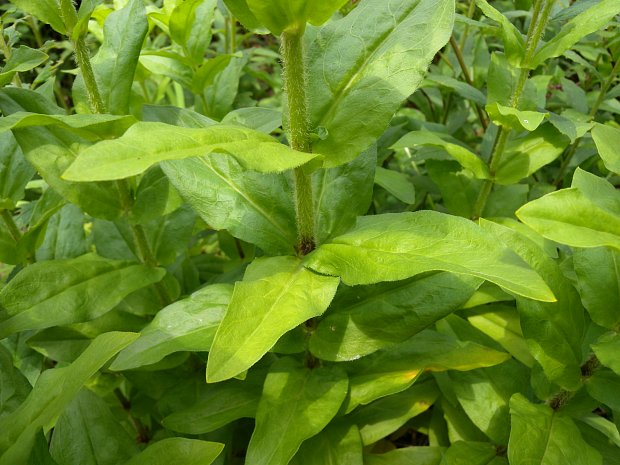
The calyx is about ¾" long and narrowly tubular in shape, becoming slightly wider toward its apex; it has 10 longitudinal ridges that are hairy. The teeth of the calyx are narrowly triangular. The stamens and styles are slightly exserted above the spreading petals. The pedicels of the flowers are nearly sessile to ¼" long, light green, terete, and hairy. The blooming period occurs from early to mid-summer, lasting about 2-3 weeks. The flowers have a tendency to bloom all at once. There is no noticeable floral scent. Afterwards, the flowers are replaced by ovoid seed capsules that are open above, where they are 5-toothed. These seed capsules are about 8-9 mm. (1/3") long. Each seed capsule contains many tiny seeds that are about 1 mm. long, dark reddish brown, and short-reniform in shape; the seed surface is minutely tuberculate (bumpy). The root system consists of a taproot, from which short rhizomes may develop.
Cultivation: The preference is full or partial sun, more or less mesic conditions, and soil containing loam. This perennial plant tends to be short-lived. It is not aggressive.

Range & Habitat: Maltese Cross (Silene chalcedonica) rarely occurs as a naturalized plant in Illinois; it has been reported from only a few counties (see Distribution Map). It was introduced into North America from abroad as an ornamental garden plant; it is native to Russia (including Siberia), Mongolia, and NW China. In Illinois, naturalized plants are found in areas with a history of disturbance, such as roadsides, areas near gardens, and vacant lots. In its native lands, Maltese Cross occurs in such habitats as grassy meadows, river valleys, open woodlands, and woodland borders. It is still cultivated in flower gardens.
Faunal Associations: Little is known about this plant's relationships with fauna in North America. In Illinois, the flowers are probably visited by Ruby-throated Hummingbirds and possibly Swallowtail butterflies (Papilionidae). Both nectar and pollen are available as rewards to floral visitors. The Maltese Cross (Silene chalcedonica) is a host plant for the larvae of a fly, Amauromyza flavifrons. The larvae of this insect are blotch leaf-miners (Ellis, 2013); this fly is found in both the Old World and New World. Other insects that feed on Silene spp. include the Pale Tortoise Beetle (Cassida flaveola) and the Elder Aphid (Aphis sambuci); the latter insect uses Silene spp. as occasional summer hosts (Clark et al., 2004; Blackman & Eastop, 2013). However, it is still uncertain if they also feed on the Maltese Cross. This plant's relationships with vertebrate animals are currently unavailable.

Photographic Location: A flower garden at the University of Illinois in Urbana, Illinois.
Comments: The common name of this plant refers to the superficial resemblance of its flowers to the shape of a cross by the same name. The Maltese Cross (Silene chalcedonica) is unusual in having scarlet flowers, particularly for plant species in temperate areas of the Old World. In North America, it resembles other Silene spp. with red or scarlet flowers; examples of the latter include Fire Pink (Silene virginica) and Royal Catchfly (Silene regia). The Maltese Cross differs from these species in having a dense head-like cluster of flowers, and the notched tips of its flower petals are divergent, rather than parallel. Other common names of this plant are Cross of Jerusalem and Red Lightening, and another scientific name is Lychnis chalcedonica. Authorities are still divided as to which scientific name is more correct.